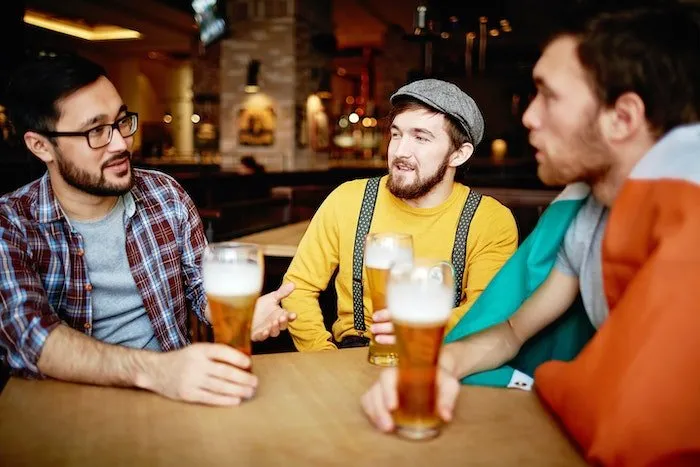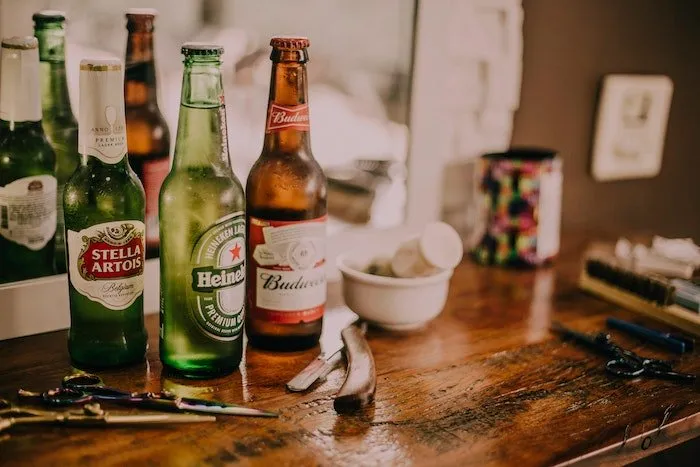Wondering how many beers will it take you to get drunk? It’s an interesting question that has been asked for centuries.
No single amount of beer can guarantee intoxication, as individual responses to alcohol vary. Factors such as weight, height, sex and age all play a role in determining your reaction to alcohol – but what about beer alcohol content? And can you really get drunk from non-alcoholic beer?
Join us on this journey as we explore these questions and more regarding “many beers to get drunk”.
Table of Contents:
- How Many Beers Does it Take to Get Drunk?
- Weight and Height as Factors for Intoxication
- Blood Alcohol Concentration (BAC) Explained
- Beer Alcohol Content Varies Across Types and Brands
- Can You Get Drunk From Non-Alcoholic Beer?
- FAQs in Relation to How Many Beers to Get Drunk
- Conclusion
How Many Beers Does it Take to Get Drunk?

Factors That Impact Intoxication:
Several factors can influence how quickly a person becomes intoxicated from drinking beer. These include body weight, height, gender, food consumption prior to drinking, rate of consumption and the alcohol content in the beer itself. The size of a person can affect how many beers they are able to consume before intoxication; those who are larger or taller tend to have greater tolerance levels.
Men generally possess greater tolerance for alcohol than women, as they have more muscle mass and less body fat. Eating before drinking also helps slow down absorption rates as it takes longer for alcohol to enter the bloodstream when there is food present in the stomach.
Law enforcement officials often use Blood Alcohol Concentration (BAC) to determine if a person has been driving under the influence of alcohol. BAC measures how much ethanol –the intoxicating ingredient found in alcoholic beverages–is present in one’s blood stream at any given time. As people consume more beers their BAC will increase until it reaches a point where they become legally intoxicated according to state laws which usually range between 0.08% – 0.10%.
Beer Alcohol Content:
Beer alcohol content can vary greatly depending on type and brand with light beers containing around 3-4% ABV while craft brews may contain up 8-12%. It’s important for individuals who plan on consuming multiple drinks throughout an evening that they pay attention not only to serving size but also ABV so that they don’t accidentally overindulge without realizing it.
Generally speaking though two regular 12 oz cans of 4% beer would equate roughly 1 standard drink per can meaning four total drinks would put most people close enough legal intoxication limits depending on other factors like weight/height etc…
Risks of Getting Intoxicated:
There are numerous risks associated with getting too drunk such as impaired judgement leading poor decision making like driving under influence or engaging risky behaviors like unprotected sex which could result in unwanted pregnancy or STD transmission among other things. Additionally being overly intoxicated increases chances of developing health problems including liver damage caused by excessive drinking over long periods time as well memory loss resulting from bingeing regularly during short durations .
Responsible drinking means understanding your own personal limitations regarding the amount consumed each session and not exceeding them no matter what situation you find yourself in. This includes setting hard boundaries about the number of drinks allowed per night beforehand so that even peer pressure won’t sway your decisions later on should the opportunity arise.
Furthermore, responsible drinkers know their limit when it comes to both frequency of imbibing along with types of beverages consumed in order to avoid potential harm to themselves and others around them.
It is essential to be aware that intoxication levels can differ depending on various elements, such as weight and height. With this in mind, let us explore how weight and height affect intoxication levels.
Weight and Height as Factors for Intoxication
Two measurements, mass and stature, can significantly affect the rate at which a person gets inebriated. It is essential to be cognizant of these elements in order to consume alcohol with moderation and evade becoming overly intoxicated.
On average, men are both taller and heavier than women. On average, adult males weigh 196 pounds and females 166 pounds, while both genders are of similar heights at 5’9″ for men and 5’4″ for women. Similarly, the average height for men is 5’9″ while the average height for women is 5’4″. These averages vary depending on age, ethnicity, body type, etc., so it’s important to know your own measurements when considering intoxication levels.
Heavier folks tend to feel less inebriated than those who are lighter when drinking the same amount of alcohol, since their bodies have more water which helps dilute the concentration of alcohol faster. Additionally, tall individuals usually require higher doses before feeling any effects as they typically possess greater lung capacity, allowing them to process oxygen and metabolize alcohol with ease.
Weight and stature may be determinative in ascertaining intoxication levels, so it is critical to grasp the consequences of these characteristics. Moving on, let’s explore Blood Alcohol Concentration (BAC) and its effects on intoxication levels.
Blood Alcohol Concentration (BAC) Explained
Blood Alcohol Concentration (BAC) is a measure of the amount of alcohol in an individual’s bloodstream. BAC is used to assess if a person has consumed too much alcohol and can no longer be legally permitted to drive or manage machinery. BAC levels are measured through breath, blood, saliva, or urine tests. The legal limit for driving in most states is 0.08%. Any level above this will result in a DUI charge.
What is BAC?
The percentage of alcohol in a person’s bloodstream, known as Blood Alcohol Concentration (BAC), can vary depending on the amount consumed, body weight and size, food intake prior to drinking and gender. A person’s BAC can be affected by many factors including how much they have had to drink, their body weight and size, food intake before drinking alcohol and even gender differences.
One can measure their Blood Alcohol Concentration (BAC) through various means, such as a breathalyzer to detect ethanol on one’s breath or a blood test that directly measures the amount of ethanol present. Saliva and urine samples also indicate BAC levels due to the presence of ethyl glucuronide (EtG), though these readings may be inaccurate if other substances like medications or vitamins are present.
What are the Legal Limits for BAC?
The legal limit for driving under influence varies across countries but typically it ranges between 0-0.08% depending on where you live with most countries having 0-0:05% set as their legal limits for drivers operating vehicles .
For example in USA, federal law prohibits anyone from operating motor vehicles with more than 0:08 % Blood Alcohol Content. However, some states have adopted stricter laws ranging from 0-0:04%, meaning any traceable amounts found would lead to criminal charges being filed against them regardless if they were impaired while driving or not .
Beer Alcohol Content Varies Across Types and Brands

No single answer can be provided when it comes to beer and its alcohol content. Various kinds of beer may possess dissimilar levels of alcohol concentration (ABV). Popular brands also vary in ABV. If you’re looking for a specific strength of beer, it’s important to look into the ABV content of different types and brands.
Different Types of Beer and Their Alcohol Content:
The ABV percentage varies from light beers such as lagers at 4% all the way up to imperial stouts at 12%. Other popular styles include pale ales (5%), porters (6%), IPAs (7%) and wheat beers (4%). Darker beers usually have higher alcohol content than their lighter counterparts. It’s important to note that craft brewers often produce speciality varieties with an even wider range of ABVs than those listed above.
Popular Beer Brands and Their Alcohol Content:
When it comes to major brands like Budweiser or Coors Light, their ABVs typically range between 4% and 5%. Still, craft breweries are now brewing stronger-alcohol beverages – so you may stumble upon a double IPA with an ABV of 8%. In addition, many craft breweries offer seasonal varieties which may have slightly higher ABVs than their year round counterparts.
Calculating your own inebriation can be done by multiplying the ounces of beer consumed with its ABV, then dividing it by 0.082 to get a BAC level (% w/v). For example; say someone drank 16 ounces of a 6% pale ale – they would take 16 x 0.06 / 0.082 = 0.90%, meaning they would reach a blood alcohol concentration level equivalent to just under 1%. Keep in mind this equation only applies when using standard drinks such as 12oz cans or bottles – not when mixing cocktails or other alcoholic beverages together
It is important to be aware of the varying alcohol content across beer types and brands, as this can greatly influence your intoxication level. It is also worth investigating if non-alcoholic brews possess any minuscule amounts of booze.
Can You Get Drunk From Non-Alcoholic Beer?
Non-alcoholic beer is a type of beverage that contains less than 0.5% alcohol by volume (ABV). For those who don’t wish to experience the intoxicating effects of alcohol but still desire the taste and flavor of regular beer, non-alcoholic beer is a suitable alternative. Despite its low ABV content, many people wonder if they can get drunk from non-alcoholic beer. The answer is no; it’s impossible to become intoxicated from drinking non-alcoholic beer due to its extremely low ABV content.
What is Non-Alcoholic Beer?
Brewers remove almost all of the ethanol from fermented liquid before bottling or canning it, a process known as de-alcoholization, to create non-alcoholic beer. This process leaves behind most of the other components found in regular beers such as water, proteins, hops and malts which gives them their unique flavors and aromas. As mentioned earlier, these beverages contain less than 0.5% ABV making them completely safe for consumption without any risk of intoxication or impairment whatsoever.
Why You Cannot Get Drunk From Non – Alcoholic Beer?
Simply put , there isn’t enough alcohol present in non-alcoholic beverages for you to experience any kind of intoxication effect even after consuming large amounts over time. For example , if you drink one 12 oz bottle containing only 0 . 5 % ABV then your body will absorb roughly 2 milliliters ( ml ) worth which equates out to just 1/10th gram . That amount simply isn’t enough alcohol present in order for your body chemistry levels to reach anywhere near what would be required in order achieve an altered state consciousness commonly referred too as being “drunk” .
FAQs in Relation to How Many Beers to Get Drunk
How many beers do you need to get drunk?
The quantity of brew necessary to achieve inebriation varies depending on numerous elements, including the kind and potency of the beer, an individual’s size/weight, how rapidly they consume it, their alcohol tolerance level, and other personal discrepancies. Generally speaking though, most people will feel intoxicated after consuming four or five beers within an hour. It is essential to bear in mind that imbibing excessively can be hazardous, so please always drink with caution.
Will 2 beers get you drunk?
No, two beers will not get you drunk. The amount of alcohol in a single beer is typically 5% ABV (alcohol by volume). This means that drinking two 12-ounce beers would only result in consuming 10% ABV or less, which is generally considered to be too low for most people to feel intoxicated. Depending on the individual’s weight and body composition, they may experience some mild effects such as increased relaxation or lowered inhibitions but these are usually quite subtle and far from being considered “drunk”.
Conclusion
Ultimately, the amount of beer required for an individual to become inebriated can vary greatly based on several elements including body size, gender and age. Blood Alcohol Content (BAC) can be utilized to decide when one has had an excessive amount of liquor. The Beer Alcohol Content also differs across beer types and brands which will affect how quickly someone gets intoxicated.
Finally, while Non-Alcoholic Beer may not make one physically drunk due to its low ABV levels, drinking in excess still carries risks of intoxication even without any alcoholic content present. It is always best practice to drink responsibly regardless of the type or amount consumed if we want our “many beers” experience be enjoyable rather than dangerous.
Discover the perfect beer for you! Get informed about brewing, tasting and subscription services to make sure your next night out is a success.

